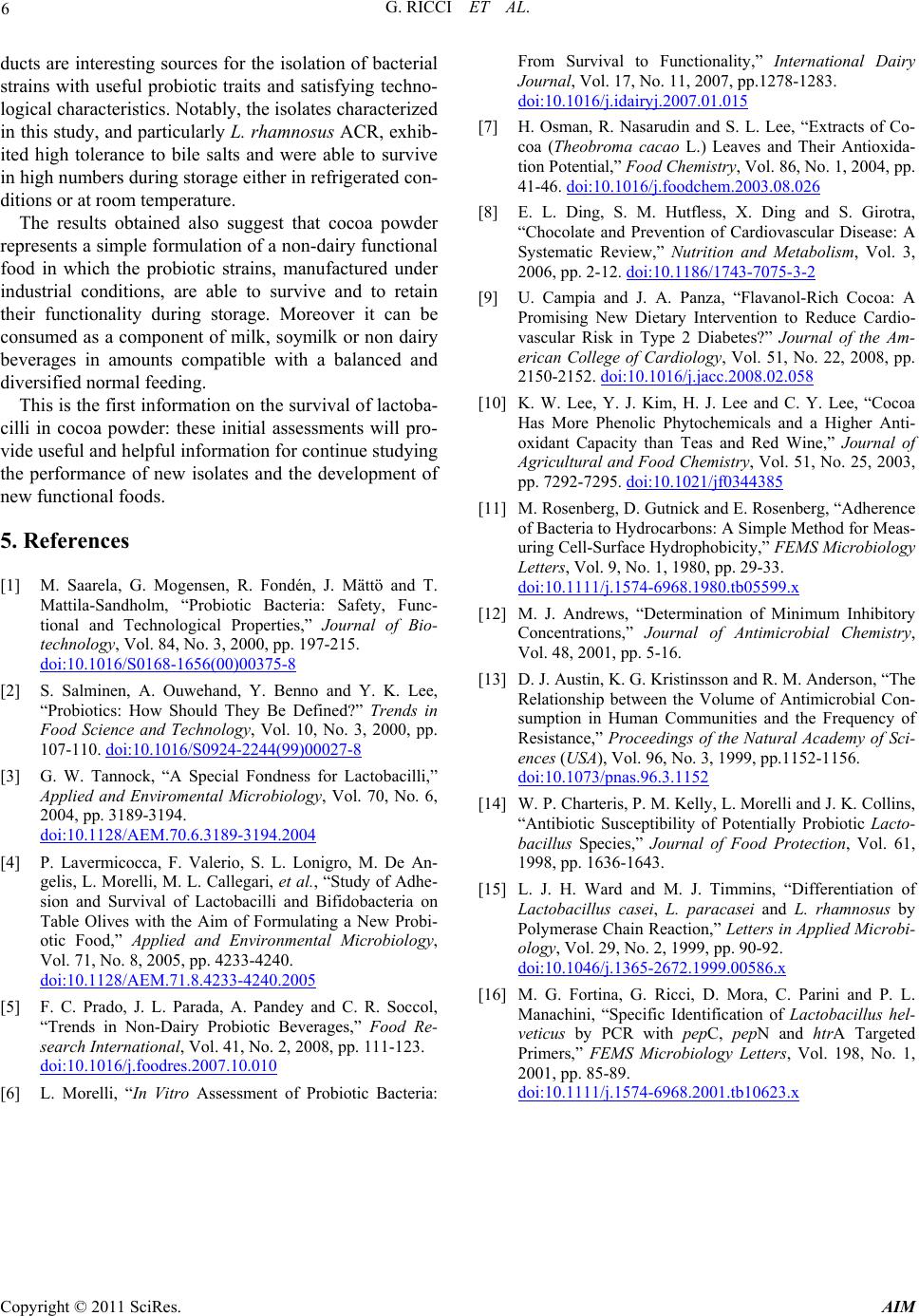
G. RICCI ET AL.
6
ducts are interesting sources for the isolation of bacterial
strains with useful probiotic traits and satisfying techno-
logical characteristics. Notably, the isolates characterized
in this study, and particularly L. rhamno sus ACR, exhib-
ited high tolerance to bile salts and were able to survive
in high numbers during storage either in refrigerated con-
ditions or at room temperature.
The results obtained also suggest that cocoa powder
represents a simple formulation of a non-dairy functional
food in which the probiotic strains, manufactured under
industrial conditions, are able to survive and to retain
their functionality during storage. Moreover it can be
consumed as a component of milk, soymilk or non dairy
beverages in amounts compatible with a balanced and
diversified normal feeding.
This is the first information on the survival of lactoba-
cilli in cocoa powder: these initial assessments will pro-
vide useful and helpful information for continue studying
the performance of new isolates and the development of
new functional foods.
5. References
[1] M. Saarela, G. Mogensen, R. Fondén, J. Mättö and T.
Mattila-Sandholm, “Probiotic Bacteria: Safety, Func-
tional and Technological Properties,” Journal of Bio-
technology, Vol. 84, No. 3, 2000, pp. 197-215.
doi:10.1016/S0168-1656(00)00375-8
[2] S. Salminen, A. Ouwehand, Y. Benno and Y. K. Lee,
“Probiotics: How Should They Be Defined?” Trends in
Food Science and Technology, Vol. 10, No. 3, 2000, pp.
107-110. doi:10.1016/S0924-2244(99)00027-8
[3] G. W. Tannock, “A Special Fondness for Lactobacilli,”
Applied and Enviromental Microbiology, Vol. 70, No. 6,
2004, pp. 3189-3194.
doi:10.1128/AEM.70.6.3189-3194.2004
[4] P. Lavermicocca, F. Valerio, S. L. Lonigro, M. De An-
gelis, L. Morelli, M. L. Callegari, et al., “Study of Adhe-
sion and Survival of Lactobacilli and Bifidobacteria on
Table Olives with the Aim of Formulating a New Probi-
otic Food,” Applied and Environmental Microbiology,
Vol. 71, No. 8, 2005, pp. 4233-4240.
doi:10.1128/AEM.71.8.4233-4240.2005
[5] F. C. Prado, J. L. Parada, A. Pandey and C. R. Soccol,
“Trends in Non-Dairy Probiotic Beverages,” Food Re-
search International, Vol. 41, No. 2, 2008, pp. 111-123.
doi:10.1016/j.foodres.2007.10.010
[6] L. Morelli, “In Vitro Assessment of Probiotic Bacteria:
From Survival to Functionality,” International Dairy
Journal, Vol. 17, No. 11, 2007, pp.1278-1283.
doi:10.1016/j.idairyj.2007.01.015
[7] H. Osman, R. Nasarudin and S. L. Lee, “Extracts of Co-
coa (Theobroma cacao L.) Leaves and Their Antioxida-
tion Potential,” Food Chemistry, Vol. 86, No. 1, 2004, pp.
41-46. doi:10.1016/j.foodchem.2003.08.026
[8] E. L. Ding, S. M. Hutfless, X. Ding and S. Girotra,
“Chocolate and Prevention of Cardiovascular Disease: A
Systematic Review,” Nutrition and Metabolism, Vol. 3,
2006, pp. 2-12. doi:10.1186/1743-7075-3-2
[9] U. Campia and J. A. Panza, “Flavanol-Rich Cocoa: A
Promising New Dietary Intervention to Reduce Cardio-
vascular Risk in Type 2 Diabetes?” Journal of the Am-
erican College of Cardiology, Vol. 51, No. 22, 2008, pp.
2150-2152. doi:10.1016/j.jacc.2008.02.058
[10] K. W. Lee, Y. J. Kim, H. J. Lee and C. Y. Lee, “Cocoa
Has More Phenolic Phytochemicals and a Higher Anti-
oxidant Capacity than Teas and Red Wine,” Journal of
Agricultural and Food Chemistry, Vol. 51, No. 25, 2003,
pp. 7292-7295. doi:10.1021/jf0344385
[11] M. Rosenberg, D. Gutnick and E. Rosenberg, “Adherence
of Bacteria to Hydrocarbons: A Simple Method for Meas-
uring Cell-Surface Hydrophobicity,” FEMS Microbiology
Letters, Vol. 9, No. 1, 1980, pp. 29-33.
doi:10.1111/j.1574-6968.1980.tb05599.x
[12] M. J. Andrews, “Determination of Minimum Inhibitory
Concentrations,” Journal of Antimicrobial Chemistry,
Vol. 48, 2001, pp. 5-16.
[13] D. J. Austin, K. G. Kristinsson and R. M. Anderson, “The
Relationship between the Volume of Antimicrobial Con-
sumption in Human Communities and the Frequency of
Resistance,” Proceedings of the Natural Academy of Sci-
ences (USA), Vol. 96, No. 3, 1999, pp.1152-1156.
doi:10.1073/pnas.96.3.1152
[14] W. P. Charteris, P. M. Kelly, L. Morelli and J. K. Collins,
“Antibiotic Susceptibility of Potentially Probiotic Lacto-
bacillus Species,” Journal of Food Protection, Vol. 61,
1998, pp. 1636-1643.
[15] L. J. H. Ward and M. J. Timmins, “Differentiation of
Lactobacillus casei, L. paracasei and L. rhamnosus by
Polymerase Chain Reaction,” Letters in Applied Microbi-
ology, Vol. 29, No. 2, 1999, pp. 90-92.
doi:10.1046/j.1365-2672.1999.00586.x
[16] M. G. Fortina, G. Ricci, D. Mora, C. Parini and P. L.
Manachini, “Specific Identification of Lactobacillus hel-
veticus by PCR with pepC, pepN and htrA Targeted
Primers,” FEMS Microbiology Letters, Vol. 198, No. 1,
2001, pp. 85-89.
doi:10.1111/j.1574-6968.2001.tb10623.x
Copyright © 2011 SciRes. AIM